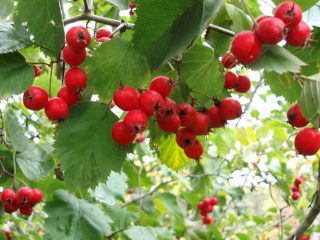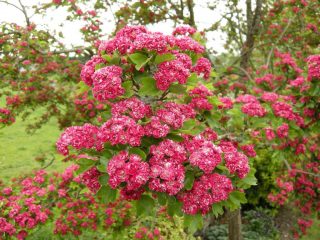Content
Many gardeners grow plum-leaved hawthorn in their plots. This plant is particularly decorative throughout the growing season. In addition to external signs, hawthorn produces a good harvest of edible fruits. The plant is unpretentious and does not require effort in care.
Description of plum-leaved hawthorn
The hybrid can be grown in tree or shrub form. The height of the plum-leaved hawthorn is from 5 to 7 m. The plant has a rather spreading asymmetrical crown, about 5 m in diameter. The skeletal stems have dense branching. On young bushes, shoots grow up to 25 cm within a year, then the growth rate slows down.
Mature trees or bushes are dense and compact. This is achieved through timely haircuts.The trunk of the plum-leaved hawthorn is brown in color, the bark is smooth with a large number of long curved spines (their length is about 5-6 cm).
Hawthorn variety Plum-leaved crataegus prunifolia is distinguished by large leaves in the shape of an ellipse. In spring and summer, the leaf blades are dark green and glossy. The upper part of the leaf is shiny. By autumn, the color changes to fiery orange or deep red.
Hawthorn blossoms begin in May and continue into June. The inflorescences are whitish-yellow, collected in umbrellas. Fruit ripening occurs at the end of September - beginning of October.
Hawthorn berries are green when they begin to set, but by the time they are picked they become blood red. The fruits of the variety are spherical in shape and contain drupe seeds inside. They are large - about 1.5 cm in diameter.
Stone fruits - “apples” of plum-leaved hawthorn are edible, sit firmly on the petioles, and retain their taste and beneficial properties until the New Year.
Characteristics of the variety
When choosing a tree or shrub variety for a site, gardeners, in addition to the description, are interested in some characteristics. This concerns the plant’s resistance to drought, frost, diseases and pests. It is equally important to know what advantages and disadvantages the hawthorn variety with plum-like leaves has.
Drought resistance, frost resistance
The word "hawthorn" is of Latin origin, meaning "indestructible." The plant fully lives up to its name, as it is drought-resistant and frost-resistant.The roots of the Plum Leaf Hawthorn are powerful, extend quite deep, and can always obtain water and nutrition.
Only young trees or shrubs need to be covered for the winter and watered in a timely manner.
Productivity and fruiting
The plum-leaved hawthorn variety is productive. The fruits are suitable for jam and compotes. Like other types of hawthorn, the berries, leaves, flowers and bark have beneficial and medicinal properties. Fruiting of the plum-leaved hawthorn variety begins at 6-7 years.
Resistance to diseases and pests
The Plum-leaved variety is resistant to many fungal diseases and pests. But we shouldn’t forget about prevention. At the slightest suspicion, the bushes are treated.
Advantages and disadvantages of the variety
The Plum-leaved variety has the following advantages:
- decorativeness;
- berries with beneficial and medicinal properties;
- versatility of fruit use;
- landing can be carried out in any region;
- The Plum-leaved variety is resistant to diseases and pests.
Among the disadvantages, gardeners in reviews note the presence of large thorns, which complicate care and harvesting. In the photo of plum-leaved hawthorn, these modified leaves are clearly visible.
Landing Features
Planting seedlings of the plum-leaved hawthorn variety will not cause difficulties. The measures are almost similar to those required for any deciduous trees or shrubs.
Recommended timing
Young bushes of the Plum-leaved variety are best planted in early spring, before the leaves bloom. During the growing season, the plant will have time to take root and produce its first growth. This shrub will successfully overwinter. Although autumn planting of hawthorn is not prohibited. You just need to plant the shrub after the leaves fall.
Selecting a suitable location and preparing the soil
In its natural environment, the shrub grows in sunny open places.
As for the soil, it should be heavy and fertile. Before planting, dig up the area and remove the roots. weed. After this, they dig a hole, the bottom of which is covered with drainage made of crushed stone, broken brick, gravel (about 15 cm). For plum-leaved hawthorn you need the following soil composition:
- turf land;
- humus;
- peat;
- sand.
In proportion 2:2:1:1.
What crops can and cannot be planted nearby?
Plum-leaved hawthorn is a friendly plant, grows with almost all crops, and does not oppress them. The main thing is that the bush has sufficient feeding area. Although there are a number of fruit trees whose proximity is undesirable due to common pests, these are;
- apple trees;
- pears;
- cherries.
Selection and preparation of planting material
Selection rules:
- It is best to purchase seedlings aged 2-4 years, no more than 1.5 m high, with a well-developed root system.
- The trunk should not have any damage or signs of disease with glossy bark.
- If the seedlings are of a variety with an open root system, then they are soaked for a day in water with potassium permanganate or in a solution that stimulates root development. If you can’t plant the plants right away, then wrap the roots in wet burlap and cellophane.
- Plants in containers also need to be prepared. The lump of earth is cut vertically to stimulate the growth of the root system.
Landing algorithm
When digging holes, they are guided by the root system of the plant: it should be twice as large.
How to plant:
- When planting, seedlings of the Plum-leaved variety are not buried above the root collar.
- The soil around the trunk is compacted and watered abundantly.
- The tree trunk circle is mulched to retain moisture.
Aftercare
The plant responds well to pruning, especially since it has the ability to form a large number of shoots. Thanks to pruning, you can get bushes of various shapes. Sanitary and formative cutting is carried out in the spring, before the movement of juice begins. Before wintering, you also need to trim off damaged shoots.
To feed this variety, boyars use organic and mineral fertilizers.
As for watering, young bushes especially need it. Mature plants are irrigated only if the summer is dry.
Deep loosening of the tree trunk circle using a shovel bayonet is carried out in spring and autumn. The rest of the time, the procedure is combined with weeding after watering. Loosen the soil to a depth of no more than 10 cm.
Since plum-leaved hawthorn is frost-resistant, adult plants do not require shelter for the winter. The trunks of young plantings are protected from frost and pests by wrapping them in burlap.
Diseases and pests, methods of control and prevention
The plum-leaved hawthorn variety, like other representatives of the crop, can be affected by fungal diseases:
- powdery mildew;
- perforated spotting;
- rust.
The main pests of the variety:
- mites;
- weevils;
- sawflies;
- silkworm;
- apple and common aphids.
If the plants are not tall, or are grown as hedges, then they can be easily treated with special preparations. An adult plum-leaved hawthorn is sprayed while standing on the stairs.
Application in landscape design
Landscape designers consider all varieties of boyarka convenient for creating original designs for gardens, parks, and summer cottages. Plants can be planted individually or in group compositions. Many gardeners use plum-leaf hawthorn to create a hedge. To do this, the growth must be cut off to half its length every year.
Conclusion
Plum leaf hawthorn is easy to grow. You just need to find him the right place and “reliable neighbors.” Throughout the growing season there will be a decorative corner on the site.


















